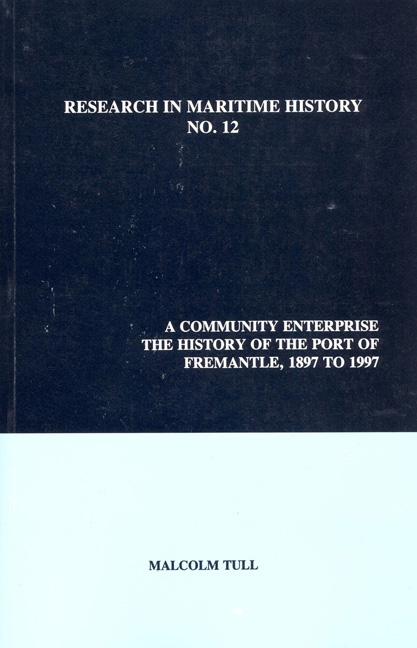Book contents
- Frontmatter
- Table of Contents
- List of Tables
- List of Figures
- List of Photos
- Acknowledgements
- Abbreviations
- Conversions
- Introduction
- Chapter 1 The Birth of A Modern Port
- Chapter 2 The Establishment of The Fremantle Harbour Trust
- Chapter 3 The Development Of Trade At The Port of Fremantle
- Chapter 4 The Shipping of Fremantle
- Chapter 5 A Century of Port Development, 1897 To 1997
- Chapter 6 Cargo-Handling Technology, Working Conditions And Industrial Relations on The Fremantle Waterfront
- Chapter 7 From Port Authority To Strategic Manager: The Transformation of The FPA
- Appendix A Trade and Shipping Statistics
- Appendix B Financial Statistics
- Appendix C Labour Statistics
- Appendix D
- Bibliography
- Index
Chapter 7 - From Port Authority To Strategic Manager: The Transformation of The FPA
- Frontmatter
- Table of Contents
- List of Tables
- List of Figures
- List of Photos
- Acknowledgements
- Abbreviations
- Conversions
- Introduction
- Chapter 1 The Birth of A Modern Port
- Chapter 2 The Establishment of The Fremantle Harbour Trust
- Chapter 3 The Development Of Trade At The Port of Fremantle
- Chapter 4 The Shipping of Fremantle
- Chapter 5 A Century of Port Development, 1897 To 1997
- Chapter 6 Cargo-Handling Technology, Working Conditions And Industrial Relations on The Fremantle Waterfront
- Chapter 7 From Port Authority To Strategic Manager: The Transformation of The FPA
- Appendix A Trade and Shipping Statistics
- Appendix B Financial Statistics
- Appendix C Labour Statistics
- Appendix D
- Bibliography
- Index
Summary
In different circumstances and at different times, the appropriate form of port administration varies. So it was at Fremantle. In chapter 2 we discussed the formation of the Fremantle Harbour Trust and the establishment of an institutional framework which survived relatively intact for over ninety years. The Fremantle Port Authority, which was created in 1964, exercised substantially the same powers and functions as its predecessor. However, as we saw in the previous chapter, in the late 1980s, as part of the wider process of waterfront reform, ports were required to improve their efficiency and operate more commercially. At Fremantle and many other Australian ports the 1990s were marked by the introduction of major institutional reforms that led to the development of a new commercially-orientated port culture.
It is commonplace to historians that changes in social and economic conditions alter the viability of institutions; but it is also true that the quality of the staff counts as much as the institutional framework in which they have to operate. Thus, it is also necessary to give due attention to the organisation and performance of the staff. Before discussing port staffing and changes in port administration, it is proposed to use some yardsticks developed in the 1920s by a British engineer, Sir George Buchanan, to evaluate port administration at Fremantle.
The Efficiency of the Administrative Framework
Buchanan's yardsticks, which have often been cited with approval by world experts on ports, are listed below:
The whole of the foreshores within the port area should be under the absolute control of the state, either directly or by delegation of power to a public corporation or trust.
Administration of the port should be free from political influence.
The port authority should include representatives of organisations interested in the port's welfare.
The port should be self-contained financially and revenues should be applied solely to its maintenance and development, any surplus being used to build up reserve funds, reduce port charges or extinguish capital debt.
Port charges should be uncomplicated, easily collected and levied so that there is an even distribution of taxation on port users. No portion of the community should be taxed for the benefit of another section and everything using the port must make a reasonable contribution towards its upkeep.
- Type
- Chapter
- Information
- A Community EnterpriseThe History of the Port of Fremantle, 1897 to 1997, pp. 243 - 278Publisher: Liverpool University PressPrint publication year: 1997

